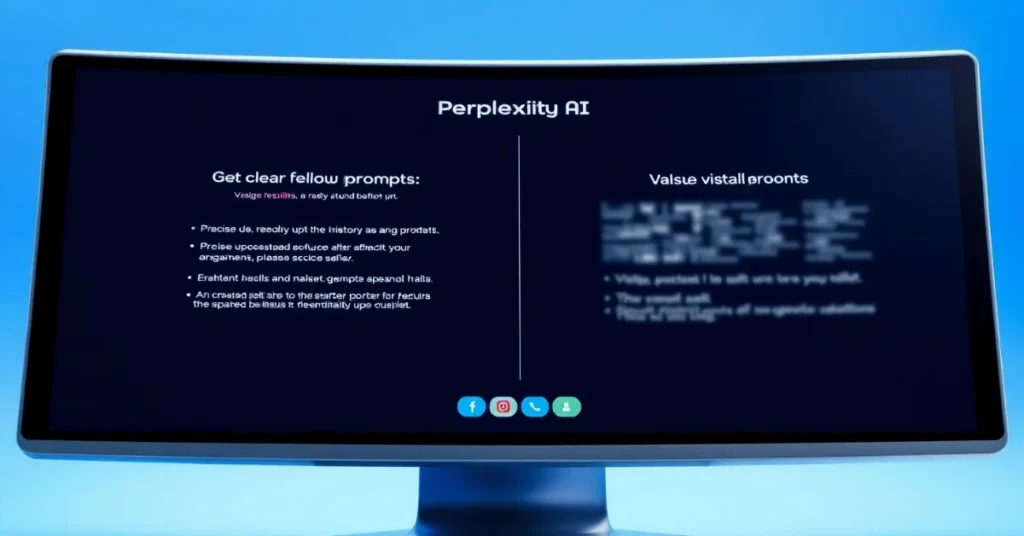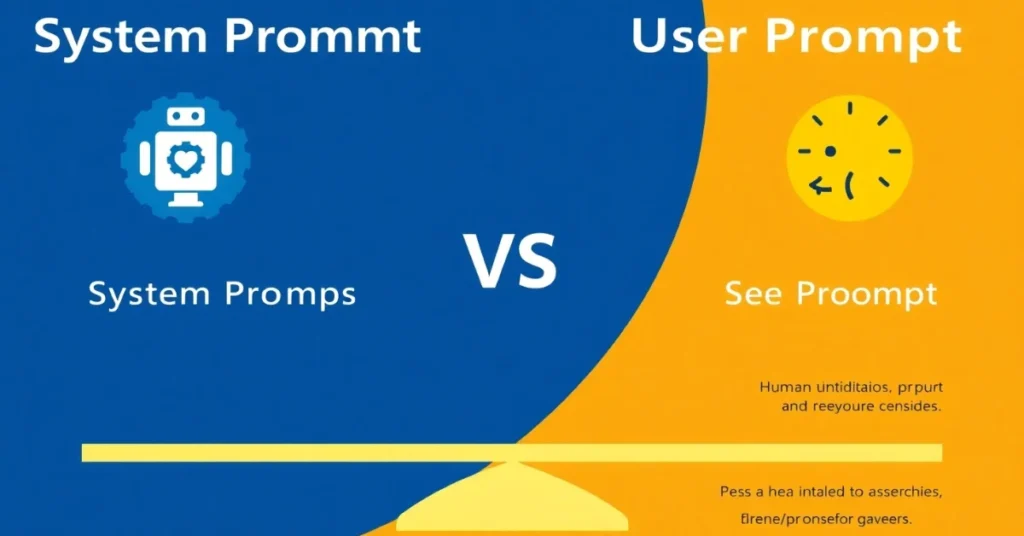Table of Contents
Brutal Follow Up Roadblocks in Perplexity AI: Navigating the world of web search can feel like traversing a labyrinth, especially when it comes to follow-up prompts. Whether you’re an AI enthusiast or just curious about how to refine your searches, understanding how to craft effective follow-ups is crucial. The way you frame your questions can significantly impact the quality of information retrieved. With the rise of complex models and conversational AI, mastering these prompt techniques has never been more important. Let’s break through those brutal roadblocks together and unlock the secrets behind successful perplexity prompts that lead to richer discussions and deeper insights.

Perplexity AI Web Search Models: General Prompting Guidelines
When engaging with web search models, understanding prompting guidelines is essential. These models rely on clear instructions to deliver accurate results. A well-structured prompt can drastically improve the quality of responses you receive.
Consider the difference between a system prompt and a user prompt. System prompts are predefined commands that help guide the AI’s behavior, while user prompts come from individual queries or requests. Knowing how to balance both types will enhance your interaction and make follow-up tactics more effective in achieving desired outcomes.
System Prompt vs. User Prompt
System prompts are predefined instructions set by the developers of web search models. They guide the Perplexity AI in understanding its role and framing responses. These prompts ensure that the model operates within a specific context, aligning with user expectations.
User prompts, on the other hand, stem from individuals seeking information or interaction. They reflect personal queries and intentions. The distinction is crucial; effective prompting relies heavily on how well users articulate their needs while being aware of the system’s limitations to achieve meaningful interactions.

Best Practices for Prompting Web Search Models
Creating effective prompts for web search models hinges on specificity and context. When you design your queries, aim to include relevant details that guide the model toward understanding your intent. This ensures that responses are more aligned with what you seek.
Avoid few-shot prompting when possible. While examples can be helpful, they may lead to unintended biases in response generation. Instead, focus on clarity to capture the user’s mindset and expectations effectively. Providing well-defined prompts enhances engagement and leads to better conversation flows within AI interactions.
Specificity and Context in Prompts
Specificity is key when crafting conversation prompts. The more detailed your prompt, the better the AI can understand and respond accurately. Avoid vague language that may lead to broad or irrelevant answers.
Providing context enhances the effectiveness of follow-up prompts. When you include situational details, it allows for a deeper understanding of user intent. This ensures that responses are not only relevant but also tailored to specific needs, making interactions smoother and more productive.

Avoiding Few-Shot Prompting
Few-shot prompting can lead to inconsistencies in web search models. When you provide only a handful of examples, the AI might misinterpret context or intent. This can frustrate users who expect precise follow-up responses.
Instead, focus on crafting clear and comprehensive prompts that guide the model effectively. Include ample context and establish expectations for responses. By doing so, you enhance the likelihood of receiving accurate results while navigating through complex topics with ease. This approach maintains user engagement and satisfaction across various queries.
Understanding Web Search User Mindset
To effectively engage with users, it’s crucial to understand their mindset during web searches. Many people seek quick answers or solutions to specific problems. They often have a particular intent that guides their queries and influence how they interact with search models.
Users may feel frustrated if prompts don’t align with their expectations. Recognizing this can help create more tailored follow-up tactics, ensuring the dialogue remains relevant and engaging. By addressing user pain points accurately, you can foster a smoother interaction and enhance the overall experience of your audience. Brutal Follow Up Roadblocks in Perplexity AI.
Providing Relevant Context for Effective Prompts
Providing relevant context is crucial for creating effective prompts. When users provide background information, it allows web search models to generate more tailored responses. Context helps narrow down the vast amount of data available, leading to precise and actionable insights.
Including specific details about the query can enhance understanding and relevance. For instance, mentioning a particular industry or scenario can guide AI follow-ups in a direction that meets user expectations. This approach minimizes confusion and increases satisfaction with the results received from conversational follow-ups.

Web Search Model Pitfalls to Avoid
When crafting prompts for web search models, it’s crucial to avoid overly generic questions. Such queries can lead to vague responses that fail to meet user needs. Specificity enhances the relevance of results and encourages more precise interactions.
Another common pitfall is assuming search intent without context. Misinterpreting a user’s request can derail the entire conversation flow. Always consider what users might be looking for and tailor your prompts accordingly. This approach not only improves outcomes but also fosters a stronger connection with the AI’s capabilities and insights.
Overly Generic Questions and Their Impact
Overly generic questions can severely limit the effectiveness of follow-up prompts in web search models. When queries lack specificity, they often yield vague responses that do not address user needs. This can frustrate users and lead to disengagement, as their intent remains unclear. Brutal Follow Up Roadblocks in Perplexity AI.
Moreover, such broad inquiries may drown out valuable insights that more targeted questions could uncover. Users might feel lost in a sea of information without actionable guidance. Tailoring prompts enhances clarity and relevance, ultimately improving user experience with AI-driven systems like perplexity models.
Challenges of Traditional LLM Techniques
Traditional LLM techniques often struggle with context retention. They can lose track of nuanced details during lengthy conversations, leading to irrelevant or incomplete responses. This inconsistency hampers effective communication and distorts user intent. Brutal Follow Up Roadblocks in Perplexity AI.
Additionally, they may falter when faced with ambiguous queries. Without clear direction, these models might provide generic answers that fail to satisfy users’ specific needs. This lack of precision makes it challenging for AI follow-ups to maintain a productive dialogue, ultimately limiting the overall effectiveness of conversational interactions in search contexts.

Dealing with Complex Multi-Part Requests
Complex multi-part requests can create significant roadblocks in web search models. These prompts often involve multiple layers of information, making it challenging for AI to deliver accurate and relevant responses. When users ask questions that require several components or steps, the likelihood of confusion increases. Brutal Follow Up Roadblocks in Perplexity AI.
To effectively manage these requests, break them down into simpler parts. This approach allows you to clarify each segment before combining them into a cohesive prompt. By doing so, you enhance the chances of receiving precise answers tailored to your needs while navigating potential pitfalls.
The Risks of Assuming Search Intent in Prompting
Assuming search intent can lead to misguided prompts and unsatisfactory responses. Misinterpretation of user needs often results in irrelevant information, frustrating users and hindering engagement. Brutal Follow Up Roadblocks in Perplexity AI.
This risk is particularly pronounced with vague queries where the user’s true intention remains unclear. A lack of precision can cause AI models to generate generic answers that fail to address specific concerns or questions effectively. Being mindful of this pitfall ensures more relevant interactions and better user satisfaction in follow-up scenarios, enhancing the overall effectiveness of conversational strategies.
Parameter Optimization Strategies
Parameter optimization is a crucial step in enhancing the efficiency of web search models. By fine-tuning parameters, users can significantly improve response accuracy and relevance. This involves adjusting settings such as temperature, max tokens, and top-p to better align with desired outcomes.
Experimentation plays a key role in this process. Testing different configurations helps identify which settings yield the most effective prompts for various queries. As you refine these parameters, you develop a deeper understanding of how they impact user interactions and overall model performance.

Advanced Techniques to Overcome Roadblocks
Navigating roadblocks in follow-ups requires innovative strategies. Consider leveraging conversational techniques that adapt to user responses. This dynamic approach fosters engagement and allows for smoother interactions, ensuring users feel understood.
Additionally, tailor your prompts based on query types. Recognize whether the inquiry is informational or transactional, then adjust your language accordingly. By honing in on these specifics, you can create more effective and relevant follow-up tactics that resonate with the user’s intent while breaking through common barriers in AI-driven conversations. Brutal Follow Up Roadblocks in Perplexity AI.
Innovative Approaches for Effective Prompts
Harnessing innovative approaches can significantly enhance the effectiveness of your prompts. Experiment with various prompt structures, such as open-ended questions or scenario-based queries. This encourages deeper engagement and generates richer responses.
Additionally, incorporating multimedia elements like images or videos within your prompts can provide context that transcends text alone. Utilizing diverse formats keeps interactions fresh and engaging, ultimately leading to more productive AI follow-ups in web search models. Embracing creativity in this space opens up new avenues for effective communication and user satisfaction.
Tailored Tips for Different Query Types in Web Search
Tailored tips for different query types can greatly enhance your engagement with web search models. For informational queries, ensure prompts are clear and concise to avoid ambiguity. Use specific keywords relevant to the topic at hand.
For navigational queries, be direct about intent. Clearly state what you’re searching for, whether it’s a website or an article. When dealing with transactional queries, emphasize urgency in your prompts by using terms that encourage immediate action. Brutal Follow Up Roadblocks in Perplexity AI.
By recognizing the distinct nature of each query type, you can create effective follow-up tactics that resonate well within AI frameworks like Perplexity. This approach will not only refine your search results but also foster better interaction dynamics.

Frequently Asked Questions (FAQs) About Brutal Follow Up Roadblocks in Perplexity AI
What are follow-up roadblocks in Perplexity AI?
Follow-up roadblocks occur when users struggle to refine or continue their queries effectively. This often leads to vague, irrelevant, or incomplete responses that derail conversations. Brutal Follow Up Roadblocks in Perplexity AI.
Why is specificity important in crafting prompts?
Specificity helps Perplexity AI understand user intent clearly. Detailed prompts reduce ambiguity, leading to accurate, relevant, and tailored responses instead of broad or generic answers. Brutal Follow Up Roadblocks in Perplexity AI.
What’s the difference between system prompts and user prompts?
System prompts are predefined rules that guide AI’s behavior, while user prompts are individual queries. Balancing both ensures smooth interactions and effective follow-ups. Brutal Follow Up Roadblocks in Perplexity AI.
How can context improve follow-up prompts?
Providing context—such as industry, scenario, or intent—helps narrow down responses. Context ensures that Perplexity AI delivers targeted answers aligned with user expectations. Brutal Follow Up Roadblocks in Perplexity AI.
Why should I avoid overly generic questions in Perplexity AI?
Generic questions often return vague answers that don’t address specific needs. Precise, well-framed prompts lead to richer, more actionable insights and smoother conversations. Brutal Follow Up Roadblocks in Perplexity AI.

What are common pitfalls when prompting web search models like Perplexity?
Common pitfalls include assuming user intent, using vague queries, over-relying on few-shot examples, and failing to provide enough context for complex multi-part requests. Brutal Follow Up Roadblocks in Perplexity AI.
How can I handle complex multi-part queries effectively?
Break down multi-part queries into smaller, clear steps. This structured approach helps Perplexity AI process each part, reducing confusion and improving accuracy in responses. Brutal Follow Up Roadblocks in Perplexity AI.
What role does parameter optimization play in follow-ups?
Adjusting parameters like temperature, max tokens, and top-p improves AI responses. Experimentation with settings enhances accuracy, context retention, and overall conversation flow. Brutal Follow Up Roadblocks in Perplexity AI.
What innovative strategies can overcome prompt roadblocks?
Using scenario-based questions, open-ended prompts, and multimedia context (images, videos) can enrich interactions. These methods keep engagement fresh and responses more relevant. Brutal Follow Up Roadblocks in Perplexity AI.
How should I tailor prompts for different query types?
Informational queries: Be concise and specific.
Navigational queries: Clearly state the destination (site, resource).
Transactional queries: Use urgency-focused wording to encourage action.
Brutal Follow Up Roadblocks in Perplexity AI.

2 thoughts on “Breaking Through Brutal Follow Up Roadblocks in Perplexity AI 2025🧱”